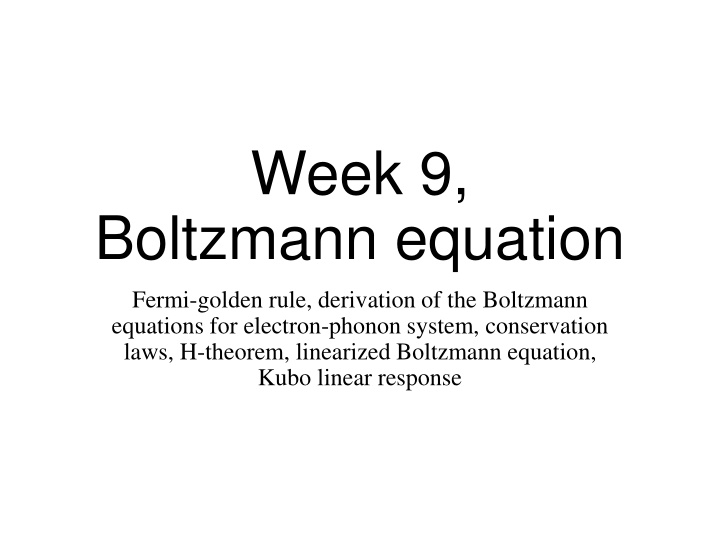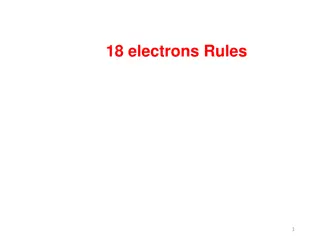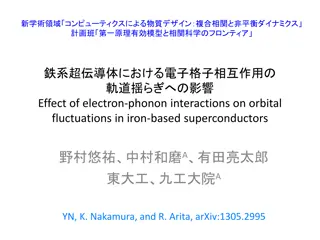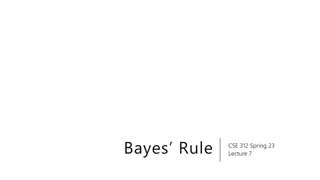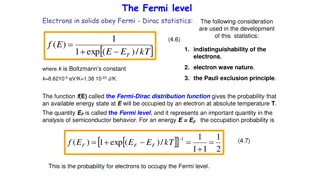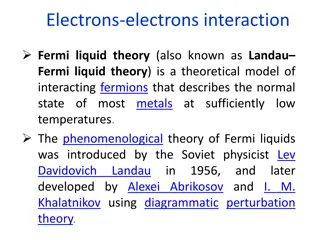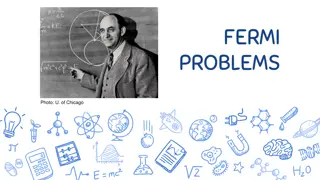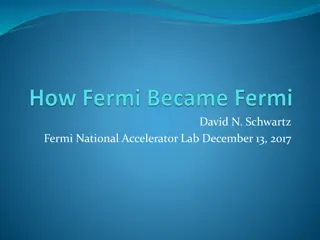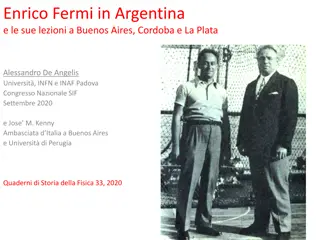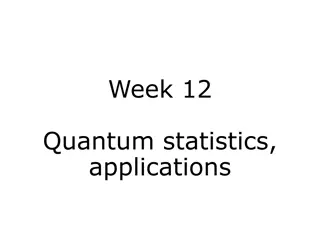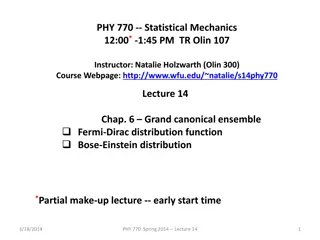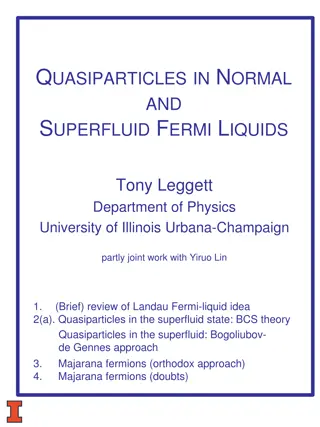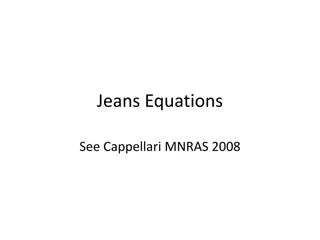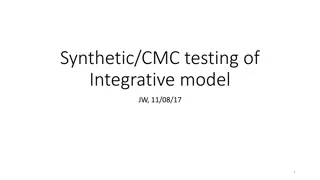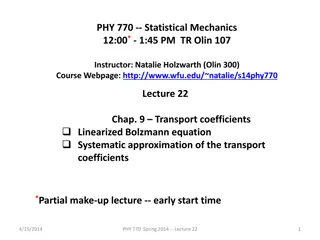Exploring Boltzmann Equations: Derivations, Fermi Golden Rule, Electron-Phonon Interactions
Delve into the realm of Boltzmann equations with a focus on Fermi-Golden Rule, electron-phonon interactions, conservation laws, and the H-theorem. Uncover the derivation process, linearized Boltzmann equations, and Kubo linear response, along with significant insights into the electron-phonon system. Explore the intricate dynamics of electron-phonon coupling and the Fermi Golden Rule application. Understand the single-mode relaxation time approximation and solve Boltzmann equations in a uniform system to elucidate the electric current density.
Download Presentation

Please find below an Image/Link to download the presentation.
The content on the website is provided AS IS for your information and personal use only. It may not be sold, licensed, or shared on other websites without obtaining consent from the author.If you encounter any issues during the download, it is possible that the publisher has removed the file from their server.
You are allowed to download the files provided on this website for personal or commercial use, subject to the condition that they are used lawfully. All files are the property of their respective owners.
The content on the website is provided AS IS for your information and personal use only. It may not be sold, licensed, or shared on other websites without obtaining consent from the author.
E N D
Presentation Transcript
Week 9, Boltzmann equation Fermi-golden rule, derivation of the Boltzmann equations for electron-phonon system, conservation laws, H-theorem, linearized Boltzmann equation, Kubo linear response
Fermi golden rule P 2 ' H ( ) 2 + H f T i = = | '| W f H i E E 0 H fi f i H 0 0 = ( ) t T c n = ( 0) t i n here H n ' H = + H 0 Tt 0 = = , H i E i H f E f 0 0 i f = = ( ) t ( ) ( 0) solve for ( ) c t n c t c t T n n ni n n 2 = ( 0 i H t P c f i f = ) ' H + ' ' n H m H nm
Derive the Fermi-golden rule iE t dc dt = + = n ' , ( ) ( ) , then n i E c H nm m c c t A t e n n n n m = (0) A n ni ( ) ) iE E T f i T ( ) i i 1 i 1 i 1 dA dt e i ( ) ) ) E E t E E t m n f i = = ' ' ' , n i H e A A H e dt H f i nm m f fi fi ( ) E E m 0 f i ( ) E E T f i 2 4sin 2 2 2 = = ' P A H f i f fi 2 ( ) E E f i 2 sin ( ) xT = use for , ( ) x T 2 x T ?? ??
Problem setup : electron- phonon interaction ,q n,k 1 2 ( ) = + + + T j 2 H c Hc p u Ku c M c u j j g 1 2 k = + + n c c k a a q k k q q n n q n 1 N ( ) + + q m,k+q m ( ) k g c c a a + k q k q q mn n , , , , m n k q c ' H = + + 0 e 0 p H H k q , : electron band indices, : electron wavevector, m n : phonon branch index, : phonon wavevector, : electron band struct : phonon dispersion q ure k n + q k k k q ( ): electron-phonon coupling matrices, is associated with , : number of repeating unit cells for g N n m mn c
Graphene band structure ??? and phonon dispersion ???
Boltzmann equations Df Dt f t f r f f t + + = = v F v , nk k e e k ( ) colli DN Dt N t N r N q N t q q + r + q = = r , colli = = = = n r r ( , ) t , ( , ) t f f c c k N N a a q k k q q n n = = k q short-hand notation: ( ), ( ) k n q
Single-mode relaxation time approximation 0 Df Dt f t f r f f t f f = + v + = = F v k , n k k ( ) colli 1 1 = = = 0 F E , ( ) f e + ( ) 1 e k T k n B `solve' the Boltzmann equation in uniform sys tem and steady state: 0 0 f f f = + = + 0 0 0 F E E v f f f e f e k k ( ) ( ) k n vv electric current density: : 3 by 3 tensor or dyadic 3 3 k k f d d = = e = E 2 j v vv E ( ) 0 e f ( ) ( ) 3 3 2 2 n k n 1BZ 1 BZ
?? ???: electron Collision rate scattering out, absorbing a phonon ( for electron, for phonon) k k q n n n k = i q ' k = whatever the scattering leads to (and will summed over) f q 1 N + + is Kroneker delta = 2 q k k k k q ( ' ) g c c a i ' ' k k q c 1 N = + + q k k k k q ( ' ) 1 1 1 1 g n n n n n n ' ' ' k k q k k q c k ( ) 2 = Apply Fermi golden rule ' Tr f H i 1 ( ) 2 = q k k (1 ) (1 ) 1 (1 ') g n n n n n n n n n f f N ' ' ' ' k k q k k q k k q N c , ' , f n f n N n ' k k q 2 1 2 + q k k k k q ( ' ) (1 f ') ( ) g f N ' ' k k q N ' k q c
Recall the properties of creation/annihilation operators boson: = = + + = 1 , 1 1 , 0,1,2, a n n n a n n n n fermion: = = + = 1 , 1 1 , 0,1 c n n n c n n n n
Collision rate electron scattering out, emitting a phonon = ( for electron, for phonon) k i n n n q ' k k q = k whatever the scattering leads to (and will summed over) f q 1 N + q k k k k k q ( ' ) g c c a i ' ' k q c 1 N = + + + + q k k k k q ( ' ) 1 1 1 1 1 g n n n n n n ' ' ' k k q k k q c k ( ) 2 = Apply F ermi golden rule ' Tr f H i 1 ( ) 2 + + + = + q k k (1 )( 1) (1 )( 1) 1 1 (1 ')( 1) g n n n n n n n n n f f N ' ' ' ' k k q k k q k k q q N c , ' , f n f n N n ' k k q q 2 1 2 + + 1) ( + q k k k k q ( ' ) (1 f ')( ) g f N ' ' q k k q N ' k q c
electron scattering in, absorbing a phonon = ( for electron, for phonon) k i n n n q ' k k q = whatever the scattering leads to (and will summed over) f k q 1 N + + = 2 q k k ( ' k k q ) g c c a i ' ' k k q c 1 N = + + q k k ( ' k k q ) 1 1 1 1 g n n n n n n ' ' ' k k q k k q c 2 Apply Fe rmi golden rule ' f H i k 1 2 q kk (1 ) (1 ) (1 ) ' f f N g n n n n n n ' ' ' k k q k k q N c , ' , f n f n N n ' k k q 2 1 2 + + q kk ( ' k k q )(1 ) ' f f N ( ) g ' ' k k q N ' k q c
electron scattering in, emitting a phonon = ( for electron, for phonon) k i n n n q ' k k q = whatever the scattering leads to (and will summed over) f k q 1 N + + q k k ( ' k k q ) g c c a i ' ' k k q c 1 N = + + + + q k k ( ' k k q ) 1 1 1 1 1 g n n n n n n ' ' ' k k q k k q c 2 Apply F ermi golden rule ' f H i k 1 2 + + + q kk (1 ) ( 1) (1 ) ( 1) (1 ) '( f f N 1) g n n n n n n ' ' ' k k q k k q q N c , ' , f n f n N n ' k k q q 2 1 2 + + + 1) ( + q kk ( ' k k q )(1 ) '( f f N ) g ' ' q k k q N ' k q c
Electron collision rate, add four terms 1 f t ( ) = (1 ) (1 ) S f f S f f ' ' ' ' kk k k k k k k N ' k colli c 2 ( ) 2 = ) ( + + 1) ( + q kk k k q ( ' ) ( ) S g N N ' ' ' ' kk q k k q q k k q q = = ( , ), = ( , k q q short-hand notation: ( , ), n ) k q q
Collision rate for phonon k, f k q q k , 1 f k N 2 1 2 ) (1 q = + ) ( + 1) (1 q kk ( ' k k q ) ( ) g f f N f f N ' ' ' ' k k q k k q k k q t N ' kk c colli Show that both collision rates are 0 at thermal equilibrium when 1 1 = = = = 0 0 q , f f N N k k q + ( ) 1 e 1 e q k
Conservation laws Electron numbers are conserved, ??= 1 ? ??3? ??? Total momentum is not conserved, as the wave vector is conserved only modulo a reciprocal lattice vector ? Energy is conserved not counting the EP interacting H term, ? = 1 ? ??3? ?????+ ? ???? H-theorem holds, entropy must increase
Prove the H-theorem 1 V ( ) ( ) = + + + + 3 r ln (1 )ln(1 ) ln ( 1)ln( 1) H d f f f f N N N N k q V show that dH dt 0 when Boltzmann equation is satisfied
Linearized Boltzmann equation 0 0 f N = = , 0 0 , , ' , f f N N ' k k q ( ) 0 0 f N = = + 0 0 0 0 (1 ), (1 ) , f f N N k q ( ) f t f dT dz f t ( ) + + = = ( ) + z q ' v eE P ' kk T N = ' , 1 k q colli c dT dz N t N N t ( ) p + = = ( 1) + + z q q ' v P ' kk T N ' kk colli c 2 2 ( 1) + = ) ( 0 0 0 q q kk k k q ( ' ' ) (1 ) ' f P g N f ' ' kk 2 2 ( 1) = + ) ( + + 0 0 0 q q kk k k q ( ' ' )( 1)(1 ) ' f P g N f ' ' kk
Relaxation time approximation (ignore off-diagonal terms in the linearized collision rates) 1 2 N 2 = + ') ( ) ( + + ') ( + q kk k k q ( ' ) (1 ' ' ) g N f N f ' ' k q c 1 = ( work out the expression for phonon ) p k : number of unit cells = number of points in 1st BZ N c
Linearized Boltzmann equation, linear nonequilibrium thermodynamics + + = = , , are known vectors F X F X F X H X 1 1 2 2 3 3 i : electric current : electron heat current : phonon heat current 1 T i X V J J J 1 dT dz 1 T dz 1 dT 2 p = = = , , F E F F 1 2 3 T 3 p = J i 3 = = , Onsager reciprocal relation: J L F L L i ik k ik ki = 1 k 1 V = = 1 1 T i T ( , is pseudo-inverse) L X H X H H H ik k 1 T 1 3 dS dt = = T entropy production: 0 F J H i i VT = 1 i
Kubo linear response theory H+F H + + t , 0 0 H H Fe F t t = ( ) t H tot , t 0 + 1 i = = t (0) (0); ( ) , j t ; [ , ] a b j dte F a b 0 1 b d H H Kubo correlation: ; Tr a b e ae eq 0 H 1 e = , = eq H k T Tr e B
